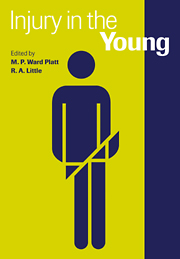Book contents
- Frontmatter
- Contents
- List of contributors
- Editors' Preface
- 1 The epidemiology of trauma involving children
- 2 Emergency room requirements for children
- 3 Child deaths in Accident and Emergency
- 4 Immediate life support
- 5 Evaluation of injury in children
- 6 Injuries of the developing brain
- 7 Wound healing in children
- 8 The lung after injury in children
- 9 Metabolic and endocrine stress responses to surgery
- 10 Head injury in children
- 11 Near drowning
- 12 The acute response to burn injury in children
- 13 Nutritional support of the severely burned child
- 14 Recovery, rehabilitation and the neuropsychological sequelae of head injury
- 15 Children's rights and child protection
- Index
7 - Wound healing in children
Published online by Cambridge University Press: 18 September 2009
- Frontmatter
- Contents
- List of contributors
- Editors' Preface
- 1 The epidemiology of trauma involving children
- 2 Emergency room requirements for children
- 3 Child deaths in Accident and Emergency
- 4 Immediate life support
- 5 Evaluation of injury in children
- 6 Injuries of the developing brain
- 7 Wound healing in children
- 8 The lung after injury in children
- 9 Metabolic and endocrine stress responses to surgery
- 10 Head injury in children
- 11 Near drowning
- 12 The acute response to burn injury in children
- 13 Nutritional support of the severely burned child
- 14 Recovery, rehabilitation and the neuropsychological sequelae of head injury
- 15 Children's rights and child protection
- Index
Summary
Wound healing in children is fundamentally the same as that seen, and classically described, in adults. Thus, while foetal wound healing is radically different from that seen after birth, that of children and adults differs only in detail. These details, however, result in clinically important features of wound healing in children.
The typical features of wound healing are illustrated in Figure 7.1. Wounds may be of various degrees of contamination and severity, but in an incised wound in which the edges are approximated healing occurs in predictable stages. First, a haematoma is formed in the wound. This acts as a source of growth factors (particularly from platelets) which act to ‘kick start’ the process of acute inflammation and wound repair. In addition, the blood clot contains a network of fibrinous material; this forms a substratum for migrating cells during the initial stages of wound repair. Both of these features are currently thought to be important in starting healing, although formal investigations of the effect of removal of the haematoma in some healing situations has revealed varying results.
The next stage of healing is the development of granulation tissue. The haematoma is invaded by granulocytes and macrophages. These cells (especially macrophages) are thought to play a vital coordinating role in wound healing. The evidence for granulocytes being important in preventing infection, both in wounds and elsewhere is clear (Weening et al., 1992). The role of macrophages is currently less clear cut.
- Type
- Chapter
- Information
- Injury in the Young , pp. 98 - 106Publisher: Cambridge University PressPrint publication year: 1998



